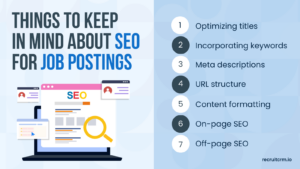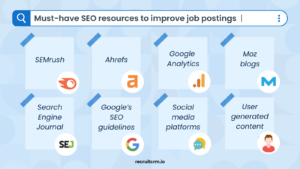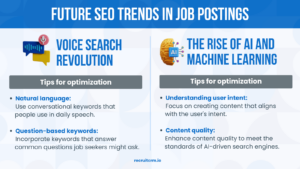During the initial stages of a hiring drive, gaining visibility for your job announcements is often the biggest challenge.
In fact, according to Google, 7 out of 10 of job searches start on search engines.
So, if you’re not optimizing your job advertisements, you’re clearly missing out on a massive talent pool.
Without further ado, allow us to help you out with everything you need to know about SEO for job postings and beyond.
Read on.
What is SEO for job postings?
No, SEO isn’t just for marketers; it is necessary for recruiters as well.
When you’re competing with millions of job postings, you need every advantage you can get.
SEO for job postings is a strategic approach that involves optimizing your job listings to rank higher on search engine results pages (SERPs).
It goes beyond just inserting keywords, encompassing a range of tactics, including crafting compelling meta descriptions, utilizing local SEO strategies, and optimizing content structure to enhance visibility and attract qualified candidates.
Leveraging SEO can be a truly decisive factor in ensuring that top talent ends up noticing your listings when they search for the relevant keyword.
Because hey, don’t you want them to find your job ads before they stumble upon your competitors’?
How to implement SEO for job postings? Top 7 strategies to adopt right away

1. Title optimization
The title of your job posting is the first thing that candidates and search engines see.
So, a well-optimized title can be a game-changer when it comes to boosting your SEO rankings.
Use your primary keyword at the beginning of the title and try to keep it under 60 characters for optimal display on search engines.
2. Keywords
Before you write your employment ad, you need to know what keywords to target. They’re the terms that potential candidates are typing into search engines.
The hack is to incorporate the ideal keywords naturally into your job description, title, meta description, and careers page.
It helps your job postings rank higher in search engine results.
For example, if you’re hiring a software developer, terms like “Java developer,” “front-end developer,” and “full-stack engineer” might be relevant.
Additionally, you should use long-tail keywords – longer, more specific keyword phrases that visitors are more likely to use when they’re closer to making a decision.
So, you can definitely expect a higher conversion rate for these on-demand clusters of words, putting you ahead in the race for the niche roles.
“Software Engineer” is good. “Software Engineer with Python experience in New York” is better.
Long-tail keywords, as you can tell, help narrow down the competition.
Pro tip: Use SEO tools like Google Keyword Planner to identify high-volume, low-competition keywords for your job postings, be it on Google or platforms like LinkedIn.
3. Meta descriptions
Meta descriptions act as the elevator pitch for your job posting – the sneak peek of what your job entails.
A compelling meta description that includes your target keywords can help entice potential candidates, significantly improving your click-through rates and performance.
Aim for a length of about 150-160 characters to ensure it displays correctly.
4. URL structure
The URL isn’t just an address; it’s an opportunity for optimization.
A clean and descriptive URL that is also keyword-rich can elevate your posting’s search visibility.
Keep it short and include the job title and location in order to take it a notch higher. For example, https://yourcompany.com/jobs/software-developer-san-francisco.
5. Content structure and formatting
A well-structured job posting is easier to read and more appealing to both candidates and search engines.
And don’t forget to break it down. Use bullet points, headers, and short paragraphs.
Strictly avoid the monotonous walls of texts – a major turnoff. The key is to make it as easy to read as an elementary textbook but as informative as an encyclopedia.
And remember – no fluffs AT ALL.
Pro tip: Use headers (H1, H2, H3) to organize your content neatly.
6. On-page SEO techniques: Headers, Alt text, and more
On-page SEO refers to all the elements on your job posting page that you can control to make it more user-friendly.
Use header tags to divide your content into easily digestible sections.
If your job posting includes images, use alt text to describe them.
And headers are not just for making text look pretty.
They help Google understand the content, crawl it accordingly, and present the same to your target audience.
7. Off-page SEO: Backlinks and authority building
Backlinks, or inbound links from other reputable websites, can significantly boost your job posting’s SEO.
The more high-quality and credible backlinks your posting has, the more authoritative it appears to search engines.
It’s like getting a thumbs-up from the cool kids in school.
You can gain backlinks by sharing your job posting on industry forums, social media, and job boards with high domain authority. It’s important to regularly conduct a backlink profile analysis to ensure the effectiveness of your efforts.
ranking score that predicts a website’s ability to rank on search engine result pages (SERPs).
How to pick the best platforms to leverage SEO for job postings?
Choosing the right platform can make or break your SEO efforts. But how do you decide which job board or social media platform is right for you?
1. Traditional platforms vs. modern platforms
Traditional job boards like Monster or CareerBuilder have been around for a while but may not offer the SEO benefits that modern platforms do.
Modern platforms like LinkedIn are built with SEO in mind and offer additional features like company pages, which can further add to your job posting’s optimization.
2. The SEO benefits of high-traffic job boards (3 modern platforms)
-
LinkedIn
High domain authority and a professional user base make LinkedIn a top choice for many recruiters. The platform also allows for detailed job descriptions, which can be optimized for target keywords.
#Note – Domain authority (DA) is a search engine ranking score that predicts a website’s ability to rank on search engine result pages (SERPs).
-
Indeed
Indeed is essentially a search engine for job postings. It has high domain authority and excellent SEO features like tagging and categorization, which can help your job posting rank well.
-
Glassdoor
In addition to job postings, Glassdoor offers customer reviews, which can add an extra layer of credibility and attract more qualified candidates.
Pro tip: Use Moz’s Domain Authority Checker to assess the DA of various platforms. Higher DA often means better visibility.
3. How company websites can be SEO goldmines
While you are going about looking for the best platforms out there, your own recruitment website has the immense potential to become your handy SEO goldmine.
You have complete control over how job postings are displayed, the URL structure, and meta descriptions.
By optimizing these elements, you can make your job postings rank high in the SERPs without much fuss.
Creating content around your job postings, such as blog posts and videos, to attract more traffic also helps
8 resources you must have to succeed in SEO for job postings

SEO tools
Invest in SEO tools that can help you identify the right keywords, analyze backlinks, and track your rankings.
These platforms can give you the insights you need to continually elevate your job postings.
1. SEMrush
SEMrush is a comprehensive SEO tool that offers a plethora of features, including keyword research, site audits, and competitive analysis.
For recruiters, the keyword research feature can be invaluable.
It allows you to identify the keywords that potential candidates are using to search for jobs, giving you the insights you need to optimize your job postings.
The competitive analysis feature can also be beneficial, enabling you to see how your job postings stack up against the competition in terms of search engine optimization.
2. Ahrefs
Ahrefs is another robust SEO tool, but it’s particularly strong in backlink analysis and keyword tracking.
The backlink analysis feature can assist you in identifying who is linking to your job postings, which is crucial for off-page SEO.
The keyword tracking feature allows you to monitor how your job postings are ranking for specific keywords over time, giving you the data you need to make informed decisions.
3. Google Analytics
Google Analytics is essential for anyone serious about SEO.
You can see detailed data on how users are interacting with your job postings, especially how candidates are finding your postings (whether it’s through organic search, social media, or direct traffic).
This actionable information can help you figure out which of your SEO efforts are paying off and where you need to make necessary adjustments.
Free resources to keep you updated
4. Moz Blog
The Moz Blog is a hub of SEO knowledge you simply can’t miss out on.
It offers in-depth articles, tutorials, and case studies on a wide range of SEO topics.
These resources can be extremely useful for recruiters trying to stay on top of the latest trends and best practices.
The blog is updated regularly, so you can always find fresh, relevant content right at your service.
5. Search Engine Journal
Search Engine Journal is another “free but fantastic” asset that provides the latest news, trends, and updates in the world of SEO.
If staying ahead of the curve is your ultimate notion – let this resource become your hiring best friend.
The site covers a wide range of topics, from algorithm updates to best practices, all of which can impact how your job postings rank in search engine results.
6. Google’s SEO guidelines
When it comes to SEO, there’s no better resource than Google’s own guidelines.
These guidelines provide a comprehensive overview of what Google considers to be best practices for SEO.
This can easily become your definitive guide to understanding how Google’s search algorithm works and how to optimize your job postings accordingly.
Other effective means
7. Social media platforms
Social media platforms can act as powerful channels to amplify the reach of your job postings.
Sharing your job openings on platforms frequented by potential candidates not only increases visibility but also encourages social sharing.
As a result, it leaves a positive impact on the SEO rankings due to increased engagement and traffic to your site.
Pro tip: Encourage your employees to repost your job openings on their personal channels as well. A prudent approach is to introduce an incentive structure for the same.
8. User-generated content
Encouraging user-generated content, such as reviews or testimonials from employees, can create a positive buzz around your company and job postings.
This not only builds trust with potential candidates but also creates fresh, organic content that can enhance the SEO rankings of your job postings.
What is local SEO? 3 crucial reasons why it helps
Local SEO majorly comprises two things – geo-targeting and local keywords.
Geo-targeting allows you to focus your job posting on candidates in a specific location. This is crucial for roles that require physical presence.
Geo-targeting can improve the relevance of your job posting, leading to higher engagement and conversion rates.
Local keywords, on the other hand, include location-specific terms that candidates might use in their search.
Incorporating these into your job posting can help you rank higher in local search results, attracting more relevant candidates.
For example, if you’re hiring in New York, include “New York” or “NYC” in your job posting title and description.
Now, let’s quickly sift through the “why” behind using local SEO.
1. Higher relevance
Local SEO helps you target candidates who are not just qualified but also conveniently located.
This can save you time and resources in the recruitment process.
2. Less competition
Local keywords often have less competition than more generic terms, making it easier for your job posting to rank high in the SERPs.
3. Better conversion
Candidates who are searching for jobs in a specific location are often more committed, which can lead to higher conversion rates.
2 future trends you can’t afford to miss out on in SEO for job postings

1. Voice search
Voice search is becoming increasingly popular, and it’s changing the way people search.
This has implications for search engine optimization, including job posting SEO.
You can optimize for voice search by using natural language and question-based keywords.
2. AI and machine learning
Artificial intelligence and machine learning are making search engines smarter.
This means they’re getting better at understanding content and user intent, which should directly influence how you approach SEO.
SEO is not something you can set and forget; it is a long-term game that requires ongoing effort.
Whether you’re doing it in-house or outsourcing SEO, this article is our effort to make sure you have the expertise to implement and maintain your SEO strategy.
Remember, you may not see immediate results, but with consistent effort, you’ll see your job postings climb the rankings like a pro.
Frequently asked questions
1. How long does it take for SEO efforts to show results?
SEO is a long-term investment. While you may see some quick wins, most strategies take time to yield results. Be patient and stay the course.
2. How can schema markup enhance the visibility of my job postings?
Implementing schema markup, a code that you put on your website to help search engines provide more informative outcomes for users.
It helps in creating rich snippets that highlight key details like job location, salary, and posting date directly in the search results, potentially increasing click-through rates and attracting more qualified candidates.
3. How can A/B testing of job postings contribute to a more effective SEO strategy?
Conducting A/B testing on different elements of your job postings, such as titles, descriptions, and layouts, can help you identify what resonates most with potential candidates.
By optimizing your postings based on the output of these tests, you can create more effective SEO strategies, enhancing visibility and attracting more qualified candidates.




